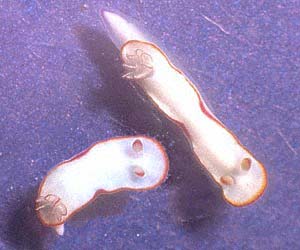
Thorunna horologia
Rudman, 1984
Order: NUDIBRANCHIA
Suborder: DORIDINA
Family: Chromodorididae
DISTRIBUTION
At present known from Tanzania and northeastern South Africa.
PHOTO
Dar es Salaam, Tanzania, 8, 12mm long alive, November, 1976. PHOTO: Bill Rudman.
This white species is characterised by a red outer line and a yellow-orange inner line at the mantle edge. about midway down the mantle on each side there is a thicker reddish purple patch which gives the body a "waist". The 'hour-glass' appearance of the mantle gave me the idea of horologia (= clock) for its species name.
References:
•Rudman, W.B. (1984) The Chromodorididae (Opisthobranchia: Mollusca) of the Indo-West Pacific: a review of the genera. Zoological Journal of the Linnean Society 81: 115-273.
•Rudman, W.B. (1985) The Chromodorididae (Opisthobranchia: Mollusca) of the Indo-West Pacific: Chromodoris aureomarginata, C. verrieri and C. fidelis colour groups. Zoological Journal of the Linnean Society, 83: 241-299.
•Gosliner, T. (1987) Nudibranchs of Southern Africa. A guide to opisthobranch molluscs of Southern Africa. California: Sea Challengers & Jeff Hamann.
Rudman, W.B., 1998 (November 11) Thorunna horologia Rudman, 1984. [In] Sea Slug Forum. Australian Museum, Sydney. Available from http://www.seaslugforum.net/find/thorhoro
Related messages
Thorunna horologia from the Andaman Sea
April 19, 2010
From: Lawrence Neal
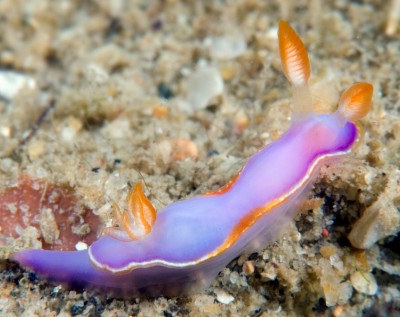
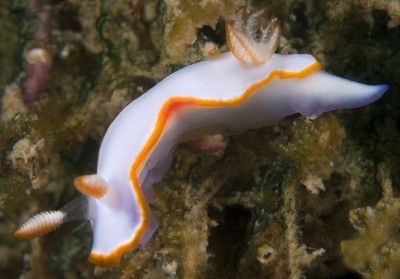
Concerning message #23489:
Dear Bill,
Following on from Vishal Bhave's message recording Thorunna africana from the Andaman Islands, here are records of another species - which I think is Thorunna horologia - from the Andaman coast of Thailand.
I have never yet seen this species in the heavily dived offshore Similan Islands, but it is locally common in shallow rocky areas (less than 10 metres deep) close to the coast. The body colour seems to exhibit a range of colour from more or less all purple to purple-white to all white, with white being the commonest. I feel that they are all the same species. Perhaps the purplish ones are juveniles?
This species is a bit bigger and more robust than Thorunna florens which is also locally common here in the same environments.
Locality: Tablamu, 6 metres, Phangnga, Thailand, Andaman Sea, Indian Ocean, Rocky shoreline. Length: 12 mm. Upper photo: 28 February 2010, Size 10 mm; Lower photo: 26 February 2010, Size 12 mm. Photographer: Lawrence Neal.
Best regards,
Lawrence
lorenzo_n@yahoo.com
Neal, L., 2010 (Apr 19) Thorunna horologia from the Andaman Sea. [Message in] Sea Slug Forum. Australian Museum, Sydney. Available from http://www.seaslugforum.net/find/23500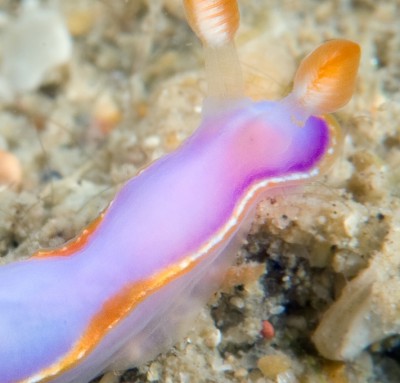
Dear Lawrence,
It would need a look at the anatomy to be safe, but from your description of colout varaition from white to purple, I would agree that this is T. horologia. Certainly the orange 'waist' on each side of the mantle link your animals with those of the western Indian Ocean. In Indo-Pacific Nudibranchs your animal is considered a species distinct from T. horologia but I suspect that is an unnecessary move. They have records from the Philippines and Indonesia so if it is T. horologia, it increases its range right across the Indian Ocean.
I have included a close-up alongside to show the small white glands which run along the edge of the mantle. These glands contain distasteful chemcials from the sponges they eat and the shape and arrangement of these glands differ within the chromodorids. They are sometimes difficult to see in species of Thorunna so this is a educational photo.
Best wishes,
Bill Rudman
Thorunna horologia and friends?
February 16, 2009
From: Valda Fraser
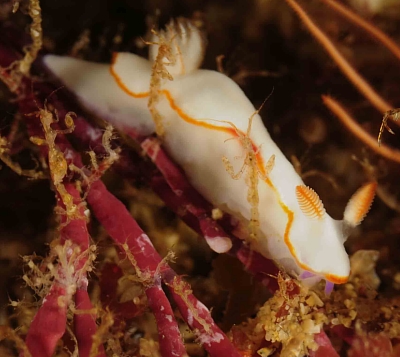
Dear Bill
Why are these "critters" crawling on Thorunna horologia? I see it often.
Locality: Park Rynie, 25 m, South Africa, Indian, 6 Feb 2009, Rocky reef. Length: 12 mm. Photographer: Valda Fraser.
Best wishes
Valda
valdafraser@mweb.co.za
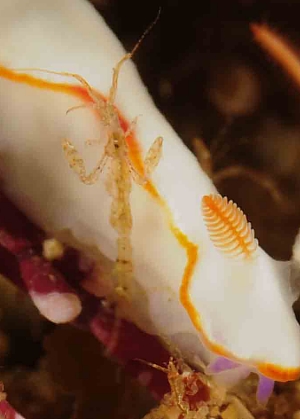
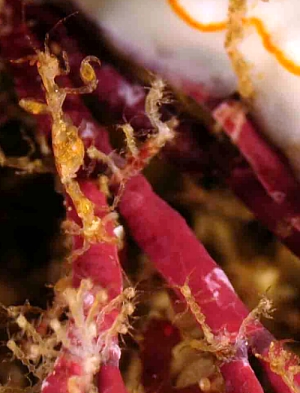
Dear Valda,
These 'critters' are caprellid amphipods - sometimes called 'skeleton shrimps' because of their shape. I have discussed a little bit about caprellids and their association with some nudibranchs in an earlier message [#19058] and you'll find a few more examples on the Forum if you search for caprellid. I have enlarged a couple of sections of your photo and one of them shows that the substrate and growths, on which Thorunna is crawling, are over-run with caprellids of various sizes. I think this is just a coincidence. If you have seen it often then perhaps the sponges that Thorunna feed on live in a place that caprellids find attractive.
On a seperate topic, your photo gives us a nice view of the purple oral tentacles. I noted in the original description of this species that specimens I had seen had the oral tentacles 'tipped with a washy purple' so it is good to get this character confirmed, as photos usually don't show it.
Best wishes,
Bill Rudman
Re: Thorunna horologia from Reunion island
February 6, 2009
From: Sully Bachel
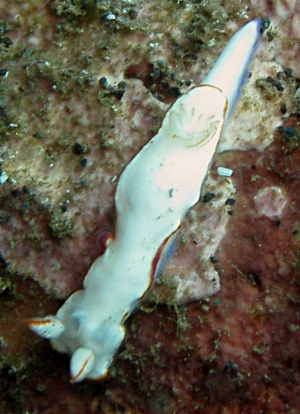
Concerning message #14035:
Dear Bill
Here is another Thorunna horologia observed in Reunion Island
At first, I think it was a Chromodoris alius that I sometimes found in my dives because its small size. But after looking the photos, I realised it was another species.
Locality: La Possession, 6 m, Reunion Island, Indian Ocean, 03 January 2009. Length: 15 mm. Photographer: Sully Bachel.
Best regards
Sully
s.bachel@orange.fr
Bachel, S., 2009 (Feb 6) Re: Thorunna horologia from Reunion island. [Message in] Sea Slug Forum. Australian Museum, Sydney. Available from http://www.seaslugforum.net/find/22220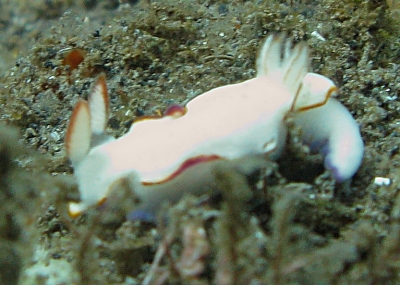
Dear Sully,
It is good to get a record of this seldom reported species, which is apparently found only in the western Indian Ocean. I suspect it is seldom seen, not because it is rare but because of its small size.
Best wishes,
Bill Rudman
Thorunna horologia from Reunion island
June 17, 2005
From: Philibert Bidgrain
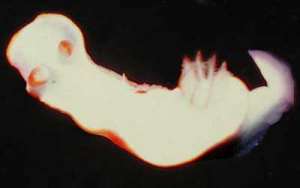
Dear Bill,
Reunion Island sea slugs.
In your Forum, you say that this animal has only been reported from Tanzania and northeastern South Africa. We have found one specimen (Observed & photographed by Maurice Jay) which seems to be a specimen of Thorunna horologia
Best Regards
Philibert Bidgrain
http://vieoceane.free.fr/runseaslug/indexslug.htm
vieoceane@free.fr
Bidgrain, P., 2005 (Jun 17) Thorunna horologia from Reunion island. [Message in] Sea Slug Forum. Australian Museum, Sydney. Available from http://www.seaslugforum.net/find/14035Dear Philibert,
This certainly seems to be T. horologia. It will be interesting to see if records remain confined to the western Indian Ocean or whether it has a wider distribution. Species of Thorunna are relatively small so I suspect they are often missed or overlooked by all but the most diligent.
Best wishes,
Bill Rudman
Thorunna horologia from Sodwana Bay
June 9, 2005
From: Colin Ogden
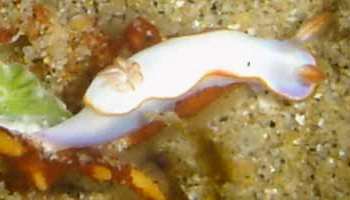
Hi Bill,
Is this a Hypselodoris bullocki.? I have never seen this nudibranch before, but I noticed it twice today, on 2 very seprated reefs. They were both extremely small less than 1cm. Does that mean they have recently hatched, and is this seasonal.
Locality: Sodwana Bay, South Africa. Indian Ocean. Depth: 24 metres. Length: 10 mm. 05 June 2005. coral reef. Photographer: Colin Ogden
Best wishes
Colin Ogden
scubaco@iafrica.com
Ogden C M, 2005 (Jun 9) Thorunna horologia from Sodwana Bay. [Message in] Sea Slug Forum. Australian Museum, Sydney. Available from http://www.seaslugforum.net/find/13974Dear Colin,
This is Thorunna horologia, a small chromodorid which doesn't grow much larger than a 10-15 mm. This animal has only been reported from Tanzania and northeasten South Africa, and then very rarely, so we can't say much about its biology and we certainly have no idea of its life history. Like many small nudibranchs it probably only lives a few months.
Best wishes,
Bill Rudman
Thorunna horologia from South Africa
April 18, 2000
From: Valda Fraser
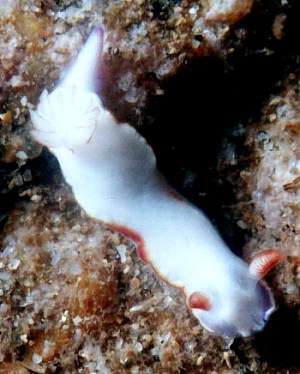
Dear Bill
Unfortunately I have no information on the size of Thorunna horologia - is it typically about 10mm long? I think this may be one!
Locality: South coast KwaZulu-Natal SOUTH AFRICA. near Port Shepstone - 18m
Date: February 2000
Size: 10mm
Regards
Valda Fraser
iti04937@mweb.co.za
Fraser, V., 2000 (Apr 18) Thorunna horologia from South Africa. [Message in] Sea Slug Forum. Australian Museum, Sydney. Available from http://www.seaslugforum.net/find/2285Dear Valda,
Yes this is Thorunna horologia, and like most species of Thorunna it is relatively small for a chromodorid, 10-15 mm would be a normal size range for adults. The two animals I have photographed at the top of the page were 8 and 12mm long.
Best wishes,
Bill Rudman.
Thorunna horologica in South Africa
November 18, 1998
From: Terry Gosliner
Dear Bill,
Thorunna horologica has also been collected from Natal, South Africa. It appears in my South African Nudibranch book.
All the best,
Terry
Terry Gosliner
tgosliner@calacademy.org
Gosliner, T., 1998 (Nov 18) Thorunna horologica in South Africa. [Message in] Sea Slug Forum. Australian Museum, Sydney. Available from http://www.seaslugforum.net/find/314Thanks Terry,
I meant to check that, but I posted it with late night enthusiasm... meaning to check in the morning. I will add it to the "Distribution" details above ... Bill
